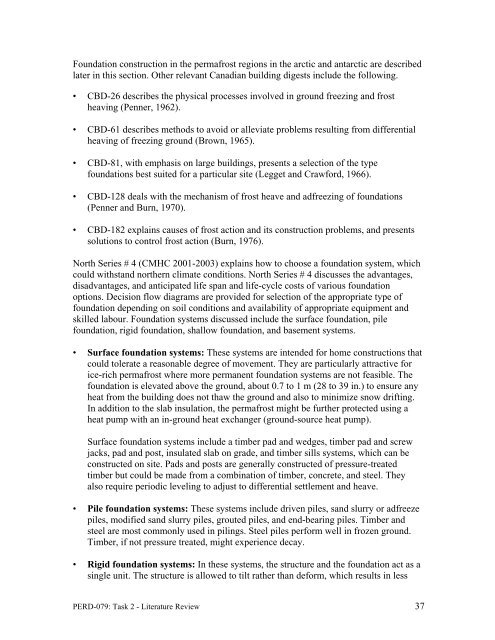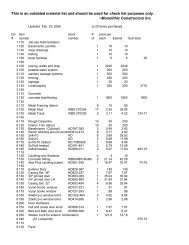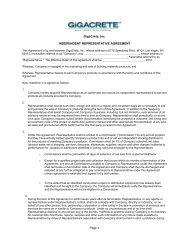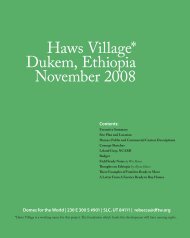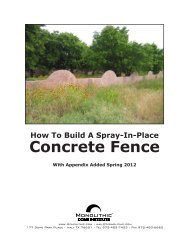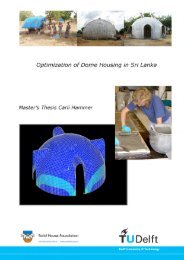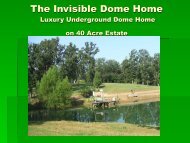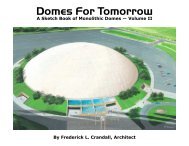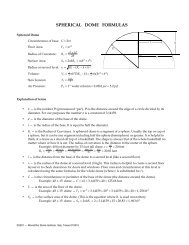Literature Review on Building Envelope, Heating and ... - Beeshive.org
Literature Review on Building Envelope, Heating and ... - Beeshive.org
Literature Review on Building Envelope, Heating and ... - Beeshive.org
You also want an ePaper? Increase the reach of your titles
YUMPU automatically turns print PDFs into web optimized ePapers that Google loves.
Foundati<strong>on</strong> c<strong>on</strong>structi<strong>on</strong> in the permafrost regi<strong>on</strong>s in the arctic <strong>and</strong> antarctic are described<br />
later in this secti<strong>on</strong>. Other relevant Canadian building digests include the following.<br />
• CBD-26 describes the physical processes involved in ground freezing <strong>and</strong> frost<br />
heaving (Penner, 1962).<br />
• CBD-61 describes methods to avoid or alleviate problems resulting from differential<br />
heaving of freezing ground (Brown, 1965).<br />
• CBD-81, with emphasis <strong>on</strong> large buildings, presents a selecti<strong>on</strong> of the type<br />
foundati<strong>on</strong>s best suited for a particular site (Legget <strong>and</strong> Crawford, 1966).<br />
• CBD-128 deals with the mechanism of frost heave <strong>and</strong> adfreezing of foundati<strong>on</strong>s<br />
(Penner <strong>and</strong> Burn, 1970).<br />
• CBD-182 explains causes of frost acti<strong>on</strong> <strong>and</strong> its c<strong>on</strong>structi<strong>on</strong> problems, <strong>and</strong> presents<br />
soluti<strong>on</strong>s to c<strong>on</strong>trol frost acti<strong>on</strong> (Burn, 1976).<br />
North Series # 4 (CMHC 2001-2003) explains how to choose a foundati<strong>on</strong> system, which<br />
could withst<strong>and</strong> northern climate c<strong>on</strong>diti<strong>on</strong>s. North Series # 4 discusses the advantages,<br />
disadvantages, <strong>and</strong> anticipated life span <strong>and</strong> life-cycle costs of various foundati<strong>on</strong><br />
opti<strong>on</strong>s. Decisi<strong>on</strong> flow diagrams are provided for selecti<strong>on</strong> of the appropriate type of<br />
foundati<strong>on</strong> depending <strong>on</strong> soil c<strong>on</strong>diti<strong>on</strong>s <strong>and</strong> availability of appropriate equipment <strong>and</strong><br />
skilled labour. Foundati<strong>on</strong> systems discussed include the surface foundati<strong>on</strong>, pile<br />
foundati<strong>on</strong>, rigid foundati<strong>on</strong>, shallow foundati<strong>on</strong>, <strong>and</strong> basement systems.<br />
• Surface foundati<strong>on</strong> systems: These systems are intended for home c<strong>on</strong>structi<strong>on</strong>s that<br />
could tolerate a reas<strong>on</strong>able degree of movement. They are particularly attractive for<br />
ice-rich permafrost where more permanent foundati<strong>on</strong> systems are not feasible. The<br />
foundati<strong>on</strong> is elevated above the ground, about 0.7 to 1 m (28 to 39 in.) to ensure any<br />
heat from the building does not thaw the ground <strong>and</strong> also to minimize snow drifting.<br />
In additi<strong>on</strong> to the slab insulati<strong>on</strong>, the permafrost might be further protected using a<br />
heat pump with an in-ground heat exchanger (ground-source heat pump).<br />
Surface foundati<strong>on</strong> systems include a timber pad <strong>and</strong> wedges, timber pad <strong>and</strong> screw<br />
jacks, pad <strong>and</strong> post, insulated slab <strong>on</strong> grade, <strong>and</strong> timber sills systems, which can be<br />
c<strong>on</strong>structed <strong>on</strong> site. Pads <strong>and</strong> posts are generally c<strong>on</strong>structed of pressure-treated<br />
timber but could be made from a combinati<strong>on</strong> of timber, c<strong>on</strong>crete, <strong>and</strong> steel. They<br />
also require periodic leveling to adjust to differential settlement <strong>and</strong> heave.<br />
• Pile foundati<strong>on</strong> systems: These systems include driven piles, s<strong>and</strong> slurry or adfreeze<br />
piles, modified s<strong>and</strong> slurry piles, grouted piles, <strong>and</strong> end-bearing piles. Timber <strong>and</strong><br />
steel are most comm<strong>on</strong>ly used in pilings. Steel piles perform well in frozen ground.<br />
Timber, if not pressure treated, might experience decay.<br />
• Rigid foundati<strong>on</strong> systems: In these systems, the structure <strong>and</strong> the foundati<strong>on</strong> act as a<br />
single unit. The structure is allowed to tilt rather than deform, which results in less<br />
PERD-079: Task 2 - <str<strong>on</strong>g>Literature</str<strong>on</strong>g> <str<strong>on</strong>g>Review</str<strong>on</strong>g> 37


